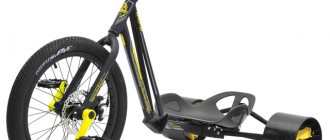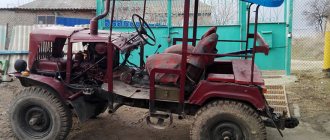Do-it-yourself three-wheeled swamp vehicle
Homemade swamp vehicle, made by yourself: photo and description of the homemade product.
This all-terrain vehicle is built for travel in off-road conditions, mud, slush, snow and swamps; the vehicle can easily overcome, and it should be taken into account that the swamp vehicle is assembled from spare parts from domestic auto-moto equipment.
The design of the swamp vehicle is shown in the photo:
To build the all-terrain vehicle, part of the frame from the Izh motorcycle was used, however, it had to be radically altered in order to install the rear axle from the Lada.
The homemade product is equipped with an engine from a motorized stroller and an additional gearbox. There is also a reverse gear.
The wheels are worn off from a Ural Lapot truck. The wheels are homemade.
There is a cardan transmission on the rear axle of the tricycle.
A homemade swamp vehicle that moves well in deep snow, mud and other off-road conditions.
Homemade author: Alexey. Omsk region. village Voznesenka.
MY MOTORCYCLE
Of course, motorcycles can be divided according to cross-country ability, but who can be called a champion....... and the winner in terms of cross-country ability can be called a little-known type of motor vehicle - pneumatic: a type of motorcycle with huge tires. Such motorcycles (and they are made of nickel) are quite popular in difficult areas of our planet: the tundra, the far north, etc.
Due to their huge size and ultra-low pressure inside (about 0.2-0.3 atmospheres), they provide a wide contact patch and, as a result, low pressure on the ground. That is why a pneumatic vehicle is capable of driving not only through any mud, swamp and snow, where there is nothing for other vehicles to “catch”, but even to swim.
Pneumatics are the most environmentally friendly type of ground wheeled transport - they do not destroy grass cover. Nature will especially highly appreciate this quality when used in the North, in the tundra, where the “scars” from any tracked or wheeled vehicles do not heal for years.
For those who are tight on money for a new snowmobile, but have their hands in the place, a motorcycle turned into a wheeled snowmobile is a panacea for all transport ills. In addition, pneumatics, in comparison with the most common snowmobiles on tracks in hard-to-reach regions, have a lot of undoubted operational advantages. The most significant thing is low fuel consumption and all-season use. Another important “plus” is a guarantee of safety during winter driving on ice in water bodies: if you get into an ice hole, you won’t drown.
A little about the variety and design
There are two- and three-track pneumatics. Three-track ones are the simplest - in their design, more than half of the “stuffing” of the motorcycle is preserved. The fact that this is really simple is confirmed by the fact that in the North all existing brands of domestic motorcycles and even mopeds are converted into pneumatics. The front fork stays are replaced by two pipes with strongly spread lower ends so that a large wheel fits between them. On some, they leave the fork with the “native” motorcycle wheel, but attach a ski to it (in this case, the further forward the ski is placed, the better the cross-country ability on soft snow). It's easier. However, in this case, the pneumatic tire loses its buoyancy, as well as the ability to ride in the summer. Instead of a standard pendulum, an axle with two wheels is installed at the rear. Theoretically, it is possible to make a pneumatic with one wheel at the back (like a regular single motorcycle), but only stuntmen could ride such a device.
The cameras are wide, they seem to be under-inflated, because everything that rests on them is constantly “floating” - the design reacts completely inadequately to obstacles. Therefore, maintaining balance on a two-wheeled caracat (from someone’s light hand this ironic nickname was assigned to pneumatics) is very difficult. Although judging by the photo, “Kulibin” solved the problem - he put skis on the sides!
As an option, a pneumatic circuit with a front ski instead of a wheel! So, the two rear wheels are mounted on the same axle. In the simplest designs they are always rigidly connected to the axis. Due to this, high throughput of the device is achieved. But serious problems arise in corners. More precisely, on slippery soils (snow, mud, swamp) there are no problems, since one wheel slips freely. But on dry surfaces it is difficult to make a turn along a small radius: resisting the maneuver, the rubber is greatly deformed and wears out faster. You will get rid of this if you install a differential, for example, from “Ant”. Unfortunately, its design does not include a locking device, and this is a big disadvantage when driving on “steep” off-road conditions. Many do-it-yourselfers solve the problem simply: they always make only one wheel leading, which is quite enough when driving on hard, dry surfaces. And when the ground grip of the chamber is not enough, the second wheel is also firmly fixed. To do this, a special pin (or bolt) is inserted into the hub and axle.
1. Pneumatic with intermediate gear. 2. All-wheel drive pneumatic with a “breakable” frame. 3. Pneumatic “4x4” with differential from “Ant”. 4. Pneumatic with a differential from “Ant”, turning due to the braking of the wheels. The ideal option is to use a bridge from the Kovrov four-wheeler “ZDK-175 4ShP”. Its design provides reduction gear, reverse gear and differential lock. However, buying such a bridge is quite difficult, and its cost is probably comparable to the price of a new motorcycle. Due to the fact that the wheel diameter is almost twice as large as that of standard motorcycle wheels, the transmission ratio will have to be increased. There are three ways to do this: install the above-mentioned “Zidov” bridge, in which there is a reduction gear; make a driven sprocket of “huge” dimensions (with the number of teeth 70-100). Or introduce an intermediate downshift. It is extremely simple: a shaft on two bearings and a pair of sprockets. Most designers follow this path. All power transmissions in such a transmission are carried out by chains. Often, combine harvester chains with an unusually large pitch for motorcyclists are used for this - 25.4 mm. By summer, the three-track pneumatic is usually converted back into a regular motorcycle.
Double-track pneumatics are made with four, less often six-wheeled ones. Their cross-country ability is significantly higher than three-track ones. This is understandable: the more wheels (in some models they are all driven), the easier it is to overcome the resistance to movement. But you have to pay for higher cross-country ability - such a device has little in common with a road motorcycle, it cannot be a transformer - you cannot turn it into a two-wheeled motorcycle by summer. This is a serious car: with a completely homemade frame, most of its components are homemade. Few four-wheeled pneumatics retain the motorcycle riding position and controls. Most have car comfort: seats with backrests and a heated cabin.
Some designers increase the buoyancy of cars: they make the hull airtight, install a propeller or an additional outboard motor.
Turning of double-track pneumatics is carried out like an automobile (with the front wheels) or by means of a “breaking” frame. Less common are tractor-like turning patterns - with the braking of wheels located on one side of the vehicle. Pneumatic suspensions are most often absent - their role is played by the cameras themselves. The vertical deflection of the chambers can reach up to 150 mm, which is equivalent to the travel of the suspensions. However, for driving at high speed over rough terrain, energy-intensive suspensions are still far from unnecessary. Tubes from all-terrain trucks or agricultural trailers are used as tires on pneumatics (it’s not difficult to understand why not bicycles). The “squarer” the chamber is in cross-section (that is, the closer the ratio of the chamber width to the bore diameter), the better. As practice has shown, the best cameras are from airplanes and helicopters. They are made from rubber of the best composition. The quality of their manufacture is also significantly higher: the thickness of the walls of these chambers is the same at all points. If aircraft cameras cannot be obtained, home-made cameras are content with products from ordinary trucks, and they are paired - attached side by side to each other.
It is not difficult to make disks (framework) for attaching any cameras. They are attached to the disks with belts, usually with a conveyor belt from agricultural machines. There are also specially designed ultra-low pressure wheels. They are a tubeless thin-walled tire with a mechanically fastened sidewall to a special disk. They also use wheels from the Arctictrans association - with light, thin-walled corded tires. The wheels have a small tread and are therefore more durable. One thing is bad: such wheels are rarely found on sale, and their price is high, so they are difficult for DIYers to obtain. No matter how you look at it, there is no such thing as perfect
There is no such thing as perfect in technology. Pneumatics also have disadvantages. The first and most important scourge of “crooks” is the fragility of the cameras. The large dimensions of the wheels and the absence, as a rule, of a differential make these cars clumsy, and the low pressure in the chambers deprives the driver of precise control. When driving at above-zero temperatures, dirt and water flying from the wheels are annoying - it’s not at all easy to cover such large wheels with wings. Therefore, it is better not to drive on public roads with pneumatic tires. The cross-country ability of a pneumatic in deep snow is still worse than that of a tracked snowmobile (at least the Buran). Only all-wheel drive 4- and 6-wheeled designs can compete with Buran in cross-country ability.
A little history
The human desire to increase the cross-country ability of a motorcycle is as old as the motorcycle itself, but the most successful version of its implementation - designs on ultra-low pressure tires - appeared relatively recently. It is difficult to say exactly who and where built the first pneumatic. But as an option, we can consider the apparatus of Tula father and son Vladimir and Vyacheslav Laukhin to be the first to be “lit up” in the press. In the early 80s, living in Tula and not having a scooter was considered bad manners. He was in the Laukhin family. The head of the family attached two cameras from a farm trailer to his semi-homemade “Ant” in place of the rear wheel, and a plywood ski in front. On this all-terrain vehicle, the inventors plowed through suburban swamps, fields, and frozen ponds. There were some incidents: more than once at night, truck drivers, not figuring out where the road was in the dark, drove onto a slightly snow-covered track from an “Ant” all-terrain vehicle and... ended up in arable land. They say they were looking for an inventor to punch them in the face... Like ripples on the water, rumors about a miracle device spread in all directions. The idea of the people's "rogue" was picked up and the magazine "Modelist-Constructor" began to "promote". All-Union Society of Inventors and Innovators, DOSAAF. From 1984 to 1991, all-Union competitions for home-made pneumatic all-terrain vehicles were held. It is curious that at the second such competition, held in Arkhangelsk, many DIYers gathered with their devices made... from plywood. In appearance they looked more like boats than land vehicles. The motorcycle engine drove two pairs of rear balanced chamber wheels from the GAZ-53. The front wheels were suspended on a transverse balancer. These are the six-wheeled caracats that appeared before the eyes of amazed journalists.
Long-distance runs across the North have become widely known. After them, the number of pneumatic ones increased sharply. By the end of the 80s, in the Arkhangelsk region alone there were 11 thousand of them, and in total there were about 100 thousand of them in the North. Naturally, with such a surge of interest in pneumatic all-terrain vehicles, attempts were made to produce them in series. In Neftekamsk, pneumatics were produced for several years, based on Voskhod. About 800 of them were collected. Later, in Zelenodolsk, at the Sergo Plant, several hundred three-wheeled motorcycles were made based on the liquid Izh Jupiter. The general decline in motorcycle production in the late 90s again transferred the production of Russian pneumatics to private garages and sheds. Recent years in the north have been marked by some surge of interest in cars with ultra-low pressure tires. The main reason is that the North needs environmentally friendly transport that does not destroy the tundra. However, a modern pneumatic is no longer the same as it was 30 - 34 years ago.
The driver and passengers are in a comfortable cabin, and high driving performance is achieved by an effective suspension and a large number of wheels (usually six), made using special technology. Yes, this is more like a car. But life was given to him by a motorcycle…….
DIY all-terrain tricycle
A powerful all-terrain tricycle made on the basis of the Izh Planet motorcycle.
Craftsman Alexander Khudyakov built a lot of equipment with his own hands; we will look at one of his homemade products in this article.
Here is a homemade all-terrain tricycle, made on the basis of an old Izh Planet motorcycle. Increased cross-country ability of the all-terrain vehicle is provided by large “flat” from the GAZ-66 truck.
The photo shows the process of stripping wheels from “Shishiga”; as a result, the tire becomes much lighter and, most importantly, a new tread is cut onto the old tire, which provides good traction when driving on dirt, snow and mud.
The all-terrain vehicle is equipped with a rear axle and gearbox from a Zhiguli. The motorcycle frame has been redone and mounts for the rear axle have been made.
The front fork has been widened and redesigned to accommodate a wide wheel.
The Izha engine is of course not designed for high loads and will often overheat, so the author has provided additional cooling for the engine.
Here is a ready-made version of a powerful three-wheeled all-terrain vehicle with “bumps”. The result is a fairly large unit, just what you need for trips in the countryside and over rough terrain.
There is also a spacious trunk and a tow hitch for a light trailer.
These are the conditions in which a homemade all-terrain vehicle is operated.
Disadvantages of a tricycle
- Instability. Still, 4 points of support provide better stability than 3. And if on a flat surface this is almost imperceptible, then on slopes and even more so on water, if the tricycle is an amphibian, this disadvantage is very significant.
- track does not match the rear wheel. This sometimes gets in the way, especially when driving on roads with deep ruts.
- Worse cross-country ability compared to similar four-wheel drive four-wheel drive vehicles. Again, I could be wrong, but I think 4 driven wheels are better than a maximum of 3. Again, all other things being equal.
- The difficulty of implementing all-wheel drive. This is my personal observation. On most all-wheel drive trikes, the front-wheel drive is often a jumble of chains and sprockets. While on four-wheel drive four-wheel drive vehicles all this is made simpler and looks much more reliable.
It seems like I haven't forgotten anything important. If you have anything to add, both advantages and disadvantages, be sure to write in the comments.
Conclusion
Three-wheeled off-road vehicles are much less common than four-wheeled ones. And it is usually represented by swamp vehicles on low-pressure tires of small-scale or home-made production. I think this is because tricycles in general are inferior to ATVs on most points, winning only in simplicity of design, weight and, perhaps, the cost of construction or purchase.
Lightweight three-wheeled karakat
The author has been making light three-wheeled caracats for about two years now. Initially, the author was going to make a three-wheeled off-road moped, but then he decided to make it for sale and accordingly build on the wishes of clients. Therefore, a similar machine was born, not large in size, but with a powerful engine. The weight of the all-terrain vehicle is under 200 kilograms, which makes it easy to transport and store.











